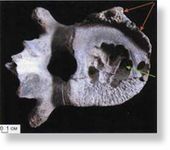
Mammoth bone with signs of a disease.
Russian scientists say that mammoths died due to geological and ecological changes, not to hordes of hunters, who killed them for food. Said changes caused severe bone diseases - the hypothesis was confirmed, when researchers examined bones from "mammoth cemeteries", areas with fossilized bones of ancient giants.
Mammoths were among the largest terrestrial mammals and roamed in Europe, Asia and North America in second half of Pleistocene. All mammoths died about 10 thousand years ago during last ice age. Many scientists tend to blame ancient hunters for extinction of mammoths. However, several researchers suggest another version of this "massacre". Researchers found mammoth bones, which carried traces of catastrophic changes - osteoporosis, osteomalacia (bone softening) and osteochondrosis nearly destroyed bones of giant vertebrates.
Ancient humans doubtlessly used any opportunity to kill the giant, especially when the animal was in a difficult situation, but sporadic mammoth murders weren't the reason of the whole species disappearance. Giant mammals died due to the lack of necessary nutrients and minerals, caused by geological changes, in soil and food.
Mammoths were very large herbivorous animals, and they needed large amounts of minerals. Like other herbivorous species, these animals compensated the lack of minerals by eating special kinds of clays at so-called "animal pastures", alkali soils. Demand to eat clays often appeared during mating season or pregnancy. Pregnant women also often eat chalk, when their organisms are in short supply of calcium.
Tectonic changes and uplift of large pieces of land, which were very fast according "geological clock" caused transformation of alkali soils into acid soils, poor in necessary nutrients. Mammoths ate grass, which lacked minerals. Mammoth needed about 150 kilograms of grass and was stressed, when didn't get enough minerals - poor animal thrashed about, trying to get them.
Lack of minerals caused various pathological processes in bones, the animals couldn't move because it was painful, thus they could not eat and breed normally. Those, who think that humans destroyed mammoths, refer to heaps of mammoth bones, found near human settlements. However, there no direct evidence that humans hunted mammoths exist.
At the moment scientists know only three obvious signs that ancient people hunted mammoths - a tip of a spear between mammoth ribs, found in the US; two spear tips in mammoth bones were found in our country. And there are much more traces, which tell us that ancient human beings hunted bisons and other hoofed mammals.
The problem of mammoth extinction is still discussed in scientific community, and scientists think that geological changes were the main reason for mass disappearing of the giants from the Earth's face. The growing Himalayas launched elevation of other lands. The end of mammoth evolution cycle - 24-17 thousand years - coincided with climate and geological changes, human beings just came on time.

Velikovsky published another book in 1955 called Earth in Upheaval which had evidence from the earth had gone under global catastrophes in prehistorically and historical times. Thus, where his first book was supported by historical and literary sources, the second book had evidence from the natural sciences, using bones and stones to show that the earth was rocked by great disturbances by forces outside the earth itself.
Over the years evidence has been mounting that supports Velikovsky idea that Venus caused a climatic catastrophe on earth. Specifically, that Venus rotates retrograde contrary to most of the other planets. And that that Venus always presents the same face to earth at the closest point in their orbits. Also, there is a wobble in the earth’s axis indicated that at some point the earth was disturbed in its orbit.